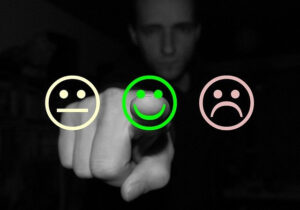We don’t know why we like something – about conscious and implicit attitudes


Our conscious opinions often differ from our implicit opinions. We don’t know what we like and why we like or dislike something. It seems to us that we judge one feature of the object, while in fact something else matters to us.
The first instant coffee, Nescafe, sold very poorly at first. Producents wondered why, since it is easier to prepare. When consumers were asked about it, they said that this coffee is less tasty than traditionally brewed coffee and for this reason they do not buy it, but interestingly, when they were given instant and brewed coffee of comparable quality to drink, not saying how they were prepared and asked for taste assessment, it turned out that they did not distinguish the flavors of these coffees. Only closer research allowed to notice that on an unconscious level, coffee that is very easy to prepare made housewives feel that they are not good housewives because they do not put enough effort into taking care of the house and therefore prefer traditional coffee. However, they did not realize why they actually prefer traditional and were convinced that it was a matter of taste (Haire, 1950 as cited in: Maison, 2004).
It was similar with the first powdered cakes. The housewives said that they would rather take the time to make the cake themselves because powdered dough has an “artificial” taste, but when given traditional and powdered dough to try, without saying how they were made, they agreed that both were equally delicious (Morgan, 1998 as cited in: Maison, 2004). It often happens that our explicit attitudes – those that we consciously declare are incompatible with our implicit attitudes, of which we are often consciously unaware. To reconcile these two attitudes, we “make up” why our attitude towards something is the way it is. In the above examples, the housewives’ explicit attitude was to admit that instant coffee and cake powder are faster and more convenient to prepare. However, this did not fit with their implicit attitude that a good housewife should devote a lot of time to her family and home. To reconcile these two attitudes, they unconsciously “made up” that instant coffee and powdered cakes are distasteful and therefore do not like them.
Also on the Polish market, one can find examples of the influence of their uncounsious attitudes on the behavior of customers. Pedros coffee was known by many potential customers in the late 1990s, but relatively few bought it. The survey showed that the problem is taste. Consumers said Pedros coffee was too bitter. However, this was not confirmed by taste tests. In taste tests, Pedros was rated as stronger and more bitter when subjects were told what kind of coffee it was than when they did not know what kind of coffee they were drinking. Only a study in which people were asked to imagine the Pedros coffee brand as a person showed what the problem is. Well, people imagined the Pedros brand as a macho man – strong, well-built, with a hot temperament, which was unconsciously translated into the taste of coffee, which seemed to them very strong (Witkowska, 2000 as cited in: Maison, 2004).
Another example of irrational consumer behavior is the story of Coca-Cola from the 1980s. On the occasion of the drink’s 100th anniversary, the manufacturer decided to improve its taste. Before introducing the “improved” Coca-Cola to the market, taste tests were carried out among potential customers, which showed that the new flavor was rated better than the old one. Sales and profits were expected to increase, but contrary to expectations, it turned out that people did not want to buy the new Coca-Cola. They were so emotionally attached to traditional Coke that, despite the objectively better tasting new Coke, they refused to drink it. As a result, Coca-Cola decided to sell two types of drink: the old Coke (Classic Coke) and the new one (New Coke) (Maison, 2004).
Smell is also often perceived on an unconscious level. In one study (Laird, 1932 as cited in: Falkowski, Tyszka, 2009) women were asked to evaluate four pairs of tights and choose the best of them. The pairs differed only in smell, which the subjects were not told about. One pair was infused with a floral scent, the second herbal, the third narcissus, and the fourth had an original scent. When choosing the best pair of tights, the study participants believed that they were guided by their strength, texture, stitching, thickness or sheen, but since all pairs of tights were of exactly the same quality, in fact, they were unconsciously guided by their smell. 50% of women chose narcissus-scented tights, and only 8% chose fragrance-free tights (with a natural scent). Out of 250 respondents, only 6 women noticed that the pantyhose they watched had any smell at all.
Opinions that consumers declare about products very often do not translate into behavior towards these products. In 2006, questionnaire and neuromarketing studies were conducted in the UK for three entertainment programs (Lindstrom, 2009): Quizmania, The Swan and How Clean Is Your House? The program How Clean Is Your House? had the highest viewership and the smallest The Swan. However, when the subjects who were given these programs were asked how much they would like to watch them on TV, it turned out that the subjects declared that they would watch The Swan and How Clean Is Your House just as willingly, and they liked Quizmania the least. Their declarations were therefore inconsistent with the actual popularity of each of these programs. Why? Because often our conscious opinions differ from our unconscious opinions. We often don’t really know what we like or why we like or dislike something. The brains of the subjects that were scanned while watching the programs using the SST (Steady State Tomography – advanced version of EEG) showed something different than their answers in the questionnaire. The study showed that viewers’ emotional engagement, measured in the frontal lobes, was highest when watching How Clean Is Your House and lowest when watching The Swan. Quizmania ranked in the middle, so the results reflected the actual popularity of the shows. So if you happen to ask yourself “why am I watching this?” you already have the answer. Even if you consciously think a show or series is stupid and not worth spending time on, your brain may like it.
References
- Falkowski, A., Tyszka, T. (2009). Psychologia zachowań konsumenckich. Gdańsk: Gdańskie Wydawnictwo Psychologiczne.
- Lindstrom, M. (2009). Zakupologia. Prawda i kłamstwa o tym, dlaczego kupujemy. Kraków: Wydawnictwo Znak.
- Maison, D. (2004). Utajone postawy konsumenckie. Gdańsk: Gdańskie Wydawnictwo Psychologiczne.
Author: Maja Kochanowska






Add comment